ZTE U5100 GSM DUAL-BAND DIGITAL MOBILE PHONE User Manual
ZTE Corporation GSM DUAL-BAND DIGITAL MOBILE PHONE
ZTE >
Users Manual
GSM Dual-Band GPRS Digital
Mobile Phone
User Manual
The manual is applicable for the U5100 mobile phone.
Copyright © 2011 by ZTE Corporation
All rights reserved.
No part of this publication may be quoted, reproduced, translated or used
in any form or by any means, electronic or mechanical, including
photocopying and microfilm, without the prior written permission of ZTE
Corporation.
The Bluetooth® trademark and logos are owned by the Bluetooth SIG, Inc.
and any use of such trademarks by ZTE Corporation is under license.
Other trademarks and trade names are the property of their respective
owners.
ZTE Corporation reserves the right to make modifications on print errors or
update specifications in this manual without prior notice.
Version 1.0 in June 2011
Contents
Let’s get started ...................................................................................................... 6
Lost or stolen? ...................................................................................................... 6
Using your phone safely ....................................................................................... 7
Battery care and safety ...................................................................................... 11
Charger care and safety ..................................................................................... 12
Getting to know your phone................................................................................ 15
Inserting and removing the SIM .......................................................................... 18
Inserting and removing a memory card .............................................................. 19
Using the battery ................................................................................................ 20
Inserting the battery .................................................................................... 20
Removing the battery ................................................................................. 21
Charging the battery ................................................................................... 21
Power on/off ....................................................................................................... 22
Using your phone ................................................................................................. 24
Common functions ............................................................................................... 26
Making and receiving calls ................................................................................. 26
making a call .............................................................................................. 26
Receiving a call .......................................................................................... 27
Adjusting the volume .................................................................................. 27
Hands-free ................................................................................................. 27
Call options ................................................................................................ 27
Sending messages ............................................................................................. 28
Viewing messages ............................................................................................. 28
Adding a new contact ......................................................................................... 29
Sending and receiving Email .............................................................................. 30
Using your phone as memory ............................................................................. 31
Main function list .................................................................................................. 32
Input what you want, how you want… ................................................................ 41
Appendix ............................................................................................................... 42
Care and maintenance ....................................................................................... 42
FCC regulations ................................................................................................. 44
Declaration of RoHS compliance ........................................................................ 48
Disposal of your old phone ................................................................................. 49
Problems and their solutions .............................................................................. 50

Let’s get started
6
Let’s get started
Thanks for choosing the ZTE U5100. It’s a GSM dual band GPRS digital
mobile phone, which we’ll simply call ‘phone’ from now on.
If you’d like your phone to live a long and fruitful life, please read this guide
carefully and keep it for future reference. You never know when you might
need it.
And don’t worry if the pictures we use to demonstrate your phone’s
functions look a little different from what you see on its screen. It’s the
functions they show that matter.
Lost or stolen?
If your phone goes missing, please tell your service provider as soon as
you know. That way other people can be barred from using it.
Obviously, it’s best to keep your phone with you at all times, and we’d
strongly advise you to set a PIN, and change it from time to time.

Let’s get started
7
Using your phone safely
on the road
Using a phone while driving is illegal in many countries. Please follow
local laws and drive safely at all times.
near sensitive electronics
Don’t use your phone near sensitive electronic equipment – particularly
medical devices such as pacemakers – as it could cause them to
malfunction. It can also interfere with the operation of fire detectors and
other automatic-control equipment.
For more information about how your phone affects pacemakers or
other electronic equipment, please contact the manufacturer or your
local distributor.
Your phone may cause interference when used near TVs, radios or
automated office equipment.
while flying

Let’s get started
8
Your phone can cause interference with aircraft equipment. So it’s
essential you follow airline regulations. And if airline personnel ask you
to switch off your phone, or disable its wireless functions, please do as
they say.
in hospital
Your phone may interfere with the normal operation of medical
equipment. Follow all hospital regulations and turn it off when you’re
asked to by posted warnings or medical staff.
at a petrol station
Don’t use your phone at petrol stations. In fact, it’s always best to switch
off whenever you’re near fuels, chemicals or explosives.
around water
Keep your phone away from water (or any other liquid). It’s not a
waterproof model.
making repairs

Let’s get started
9
Never take your phone apart. Please leave that to the professionals.
Unauthorised repairs could break the terms of your warranty.
broken antenna
Don’t use your phone if the antenna is damaged, as it could cause
injury.
around children
Keep your mobile out of children’s reach. It should never be used as a
toy and it might not be good for their health.
original accessories
Only use the original accessories supplied with your phone or those
approved by the manufacturer. Using unapproved accessories may
affect performance, make the warranty void, break national regulations
on the use of mobile phones, or even cause injury.
near explosives

Let’s get started
10
Turn off your phone in or near areas where explosive materials are
used. Always obey local laws and turn off your phone when requested.
emergency calls
To make an emergency call your phone must be turned on and in an
area where there’s network coverage. Dial the national emergency
number and press ‘send’. Explain exactly where you are and don’t hang
up until help has arrived.
working temperature
The working temperature for the phone is between 0 and 40 . ℃℃
Please don’t use the phone outside the range. Using the phone under
too high or too low temperature might cause problems.
At very high volume, prolonged listening to a mobile phone can
damage your hearing.

Let’s get started
11
Battery care and safety
Keep the battery in a cool, ventilated place and out of direct sunlight.
Although the battery is rechargeable, it’ll eventually start to lose its
ability to recharge. If you find that the battery won’t recharge, it’s time to
replace it.
Please don’t throw old batteries into your household rubbish. You’ll find
there are special bins for batteries at refuse collection points. And some
high street electrical stores provide a battery recycling service too.
Never throw the battery into a fire – it’s highly inflammable and could
explode, hurting you or somebody else.
When you put the battery into your phone, there’s no need to use force.
Exerting too much pressure could make it leak, overheat, explode or
burst into flame.
Never take the battery apart. This may result in leakage, overheating,
explosion or fire.
If the battery becomes hot, changes colour or shape at any time (when
in use, charging or even while in storage) please stop using it
immediately and replace.

Let’s get started
12
Keep the battery dry. Damp or wet conditions can cause it to overheat
or corrode.
Don’t leave the battery in direct sunlight or anywhere really hot, like in a
car on a summer’s day. That could make it leak or overheat, while
lowering its performance and shortening its life.
Don’t charge the battery continuously for 24 hours. Overcharging is not
good for it.
Note:
Please avoid contact with the materials inside a damaged or
leaking battery. If they get on your skin, wash with lots of water
and seek medical assistance if required.
Charger care and safety
Only plug into voltages between 110VAC and 220VAC. Using a voltage
outside that range can damage the phone/charger – and cause the
battery to leak or catch fire.

Let’s get started
13
Never short-circuit the charger – this may cause electrocution,
overheating or damage.
Don’t charge the phone in direct sunlight or in an area where it’s damp,
dusty, or on a vibrating surface. And charging your phone near – or on –
a TV or radio could interfere with transmission.
Don’t use the charger if the power cable is damaged. It may cause a fire
or give someone an electric shock.
Keep water well away from the charger. If the charger does get
splashed by water, or any other kind of liquid, immediately unplug it to
avoid overheating, fire or electrocution.
Don’t take the charger apart. It could cause injury, give you an electric
shock or catch fire.
Never touch any charger, electric cable or socket with wet hands.
Don’t place heavy objects on the electric cable.
If the cable is damaged, don’t try to mend it yourself – it could cause a
fire or electrocute you.
Always unplug the charger before you clean it.

Let’s get started
14
When unplugging the charger, hold the plug itself, rather than pulling on
the cable. A damaged cable can cause electrocution or fire.
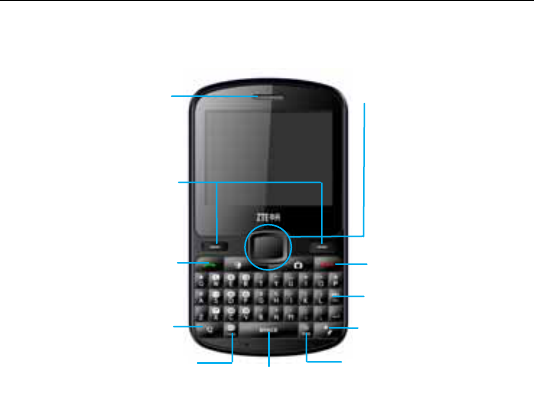
Let’s get started
15
Getting to know your phone
Carries out the operations at the
left-bottom/right-bottom corner of
the screen.
Dial a number or receive
incoming calls; In idle mode,
press the key to view all recent
ll
Function ke
y
Switch the input of the symbols
located on the upper part and
Send ke
y
End key
Caps lock
k
ey
Lock key
Press it to switch the input
method, and hold it to quickly lock
th k d
Delete key
Left/right sof
t
Space Key
Receive
r
Navigation keys and OK key
In idle mode:
Up key: Write SMS&MMS
Down key: File manager
Left key: VIVO Chip
Right key: Calendar
OK key: Enter main menu
Symbol key
When editing the text, press it to
switch to the symbol input method;
In idle mode, hold it to quickly switch
to General mode or Silent mode.
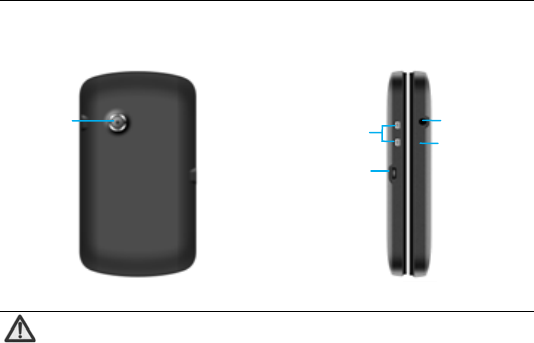
Let’s get started
16
Note:
Your phone might look a little different.
In this user guide, ‘press’ means pressing the key and then
releasing.
‘Hold’ means pressing and holding the key for two seconds or
Side keys
A
djust the
volume
USB port
Came
r
a
Memory card
socket
Headphone
j
ac
k
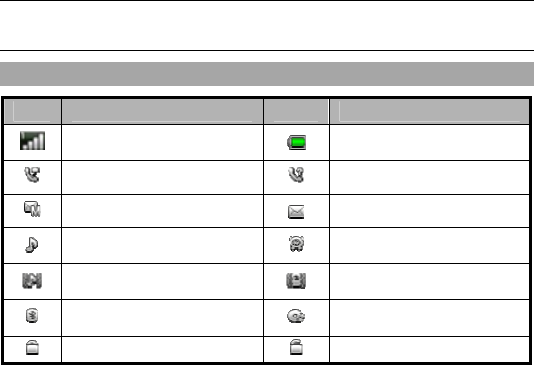
Let’s get started
17
more.
Onscreen icons
Icons Descriptions Icons Descriptions
Show the phone’s network
signal strength. Show the phone’s battery
capacity.
Calling or in call You have missed calls.
You have unread MMS. You have unread SMS.
The ringing type is set to
Ring. A clock alarm is active.
The ringing type is set to
Vibration and ring tone. The ringing type is set to
Vibration.
Bluetooth® on Audio player on
The keypad is locked. Keypad unlocked

Let’s get started
18
Inserting and removing the SIM
Your phone needs a valid SIM card to work (…To keep it simple, we’ll just
call it ‘SIM’ from now on). Your network connection data and your SIM
address book are saved on the SIM. So, to avoid damaging your SIM or
losing data, try not to touch the metal surface when you’re handling it – and
keep well away from any magnetic or electric source.
here’s what you do…
1. Switch off your phone and disconnect any external power.
2. Remove the back cover and then the battery.
3. Hold your SIM on the cut corner, and slide it
– face down – into the card holder.
4. Insert the battery.
5. Replace the back cover.
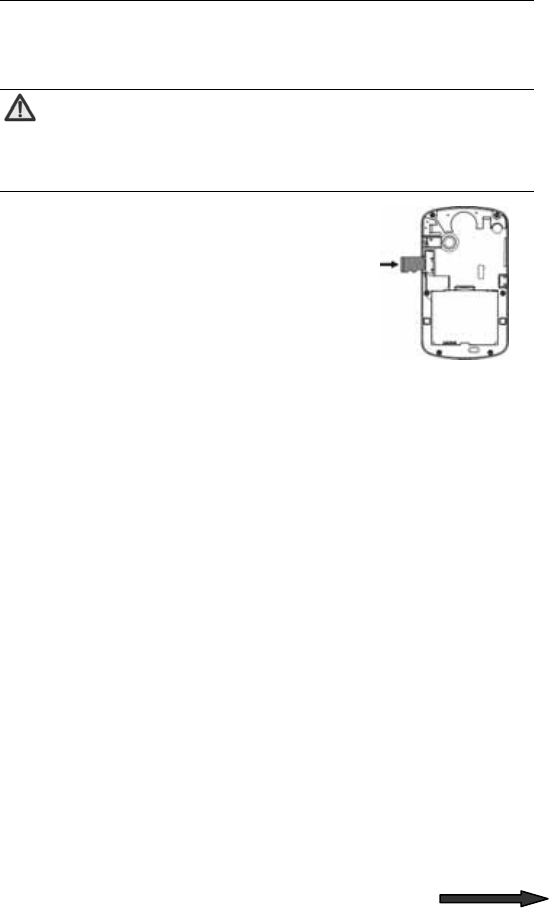
Let’s get started
19
Inserting and removing a memory card
Note:
Removing or inserting a memory card when your phone is
turned on could not only damage it and your phone, but also
destroy any data saved on the card.
1. Remove the back cover and insert the
memory card at the right side of the phone.
2. Push tightly until the card is installed in the
right position and replace the back cover.
3. Before you take out the card, please open the
back cover and press the card inward to
unlock.
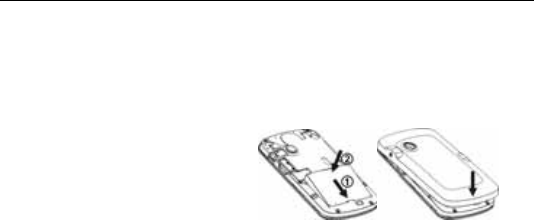
Let’s get started
20
Using the battery
Inserting the battery
1. Open the battery cover on the
back of your phone.
2. Align the battery's contact
points with those of the phone
and gently press the battery
down into place.
3. Replace the battery cover
clicking it back into position.
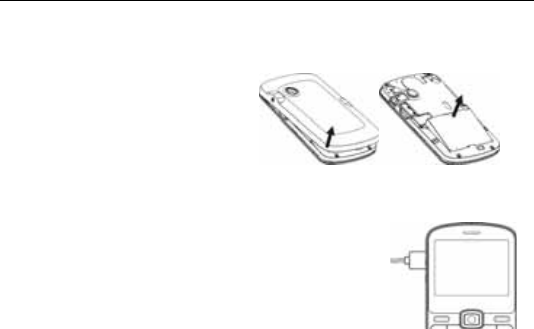
Let’s get started
21
Removing the battery
1. Switch off your phone.
2. Open the battery cover.
3. Lift the battery up and out of
your phone.
Charging the battery
The rechargeable Li-ion battery that comes with
your phone is ready to use, but is not charged.
That’s easy to do. We’ll show you how below.
The first three times you use the battery, make sure
it’s completely drained before recharging. And then
recharge it fully. That will help to ensure its optimum
performance and a long life.
1. Connect the charger to your phone, and plug it into an 110V/220V
socket.

Let’s get started
22
2. The battery indicator in the corner of the screen will scroll to show you
it’s charging. If the phone’s battery has been fully drained, the battery
indicator may not immediately appear on the screen when charging
starts. And please don’t worry if the phone and charger become warm
while charging. That’s completely normal.
3. When fully charged, the battery indicator will stop scrolling up and
down.
4. Disconnect the charger from your mobile, and unplug.
Power on/off
Press the power key until the power-on/off icon appears.
When you turn your phone on, it’ll automatically check the SIM and show
the following information on screen:
Input phone lock code: If you’ve set a lock code.
Input SIM PIN: If you’ve set a PIN for your SIM.
Note:
The PIN is supplied with your SIM. Please replace it with your

Let’s get started
23
own PIN code as soon as possible. Enter the wrong PIN three
times, and your SIM will be locked. Then you’ll need to contact
your network service provider to ask for a PUK code to unlock
it.
Searching: The mobile phone will search for the available network.

Using your phone
24
Using your phone
Select ‘Menu’ to enter the main menu…
Calls
Loja Vivo
Downloads
Vivo Downloads
Java Games &
Apps
Java settings
Java default
security
Other Games
VIVO Chip
Tools
Calendar
Tasks
Alarm
World clock
Calculator
Unit converter
Currency
Play
Vivo Play
Images
Tones
Phonebook
Camera
Camera
Video recorder
Messages
Email
Write SMS & MMS
Inbox
Drafts
Outbox
Sent messages
Archive
Delete messages
Broadcast
messages
Templates
Message
settings
Text message
counter
Multimedia
File manager
Camera
Gallery
Video recorder
Video player
Audio player
Sound recorder
FM radio
User Profiles
General
Meeting
Outdoor
Indoor
Headset
Bluetooth®
WAP
STK service
Internet service
Licence manager
MSN
Settings
Phone settings
Call settings
Network settings
Security settings
Connectivity
Restore factory
settings
Sound effects
Version information

Using your phone
25
converte
r
Stopwatch

Common functions
26
Common functions
Making and receiving calls
making a call
Direct dial: In idle mode, press the numeric keys to input the
telephone number and press Send key to dial.
Dialling from the Contacts: In idle mode, press right soft key to
enter ‘Contacts’, then select your contact and press the Send key to
dial.
Dialling from call logs: In idle mode, press the Send key to enter
the list of call logs, select the call log, and press the Send key to dial.
Saving a number: On the dialling screen, type in a contact's phone
number, select ‘Save’ to save it as a new entry, or save it over an
existing entry.
Dialling an extension: Sometimes you can’t dial an extension
directly. If this happens, dial the direct line first, press ‘p’ key and
then dial the extension number.

Common functions
27
Dialling international calls: To make an international call, press ‘+’
key and ‘+’ appears. Now you can dial anywhere in the world,
without even having to enter the international dialling code.
Receiving a call
Someone’s calling? Press the Send key to answer.
Adjusting the volume
During a conversation, you can raise or lower the volume by using the side
keys. And in idle mode, you can use the side keys to adjust the keypad
volume.
Hands-free
Select ‘H-Free’ to use your phone hands-free. Select ‘H-Held’ to be
hands-on again.
Call options
Need to multitask while you’re on a call? Just select ‘Options’ if you want to
access your contacts, messages, or other functions.

Common functions
28
Sending messages
1. In idle mode, select ‘Menu’ to enter the main menu, then select
‘Messages’ ‘Write SMS & MMS’ to edit the message text.
2. Add the recipient: input the recipient’s number and select the recipient
from “Contacts”.
3. Writing your message:
If you want to add a picture, sound, video… select ‘Options’ followed
by ‘Add picture’, ‘Add sound’ or ‘Add video’ or whatever you want.
If you want to send a multimedia message, please select ‘Switch to
MMS’.
4. After editing the message, select ‘Send’ to send the message.
5. Finally, select ‘Send’ and the message will be on its way.
Viewing messages
Your phone is very versatile. According to what you’ve selected, it can tell
you that you’ve received a new message in three different ways: a ringtone,
a prompt, or a new message icon.

Common functions
29
Press the OK key to open your inbox and read the message:
1. In idle mode, press ‘Menu’ to select ‘Messages’ ‘Inbox’.
2. All your received messages will be displayed on the screen. Use the
Up/Down key to select the message, and select ‘View’ to see the
content.
3. Then go to ‘Options’ to select ‘Reply’, ‘Forward’, ‘Delete’, or whatever
you want to do…
Adding a new contact
1. In idle mode, select ‘Menu’ and go to ‘Contacts’.
2. If you’d like to add a new contact to your phone memory, simply select
‘Add new contact’. Then you can enter all the details you want.
3. If you’d prefer to add a new contact to the SIM memory, select
‘Options’ ‘Contact settings’ ‘Preferred storage’ ‘SIM’. There you
can add the name, number and details, etc.
4. Select ‘Save’ when you’re happy with what you’ve done.

Common functions
30
Sending and receiving Email
You can send and receive Emails over the GPRS network after the mobile
phone has connected to the mail server. You have to change the following
settings before using Emails. For different email providers, the settings
may be slightly different. Please consult your email provider. The following
guide is for your reference only.
1. In idle mode, press the OK key and then select ‘Email’ ’Email accounts
setup’
2. Select ‘Options’ to create a new account.
Email address: input your E-mail address, e.g., abc@gmail.com
User name: you can remove the mail server name and just keep ‘abc’,
for example.
Password: the logon password you have set for your email account.
3. Return to ‘Email accounts setup’, select the newly created account, and
press ‘Options’ ‘Activate’.
4. After settings, you should be able to send/receive mails.

Common functions
31
Using your phone as memory
Make sure the memory card is installed and your phone is switched off,
then connect the phone to your PC with the USB data cable, and switch
your phone back on. Then select ‘Mass storage’, and you can use your
phone as extra memory.

Main function list
32
Main function list
In idle mode, select ‘Menu’ to enter the main menu. Those marked with ‘*’ need support from network
operators.
Function Description Operation
View call
history
See who’s recently called you, who
you’ve called and which calls you’ve
missed.
Calls All calls/Dialled calls/
Received calls/ Missed calls
Delete a
call log
Delete a call log. Calls Select one call log
Options Delete
View call
duration
See how long your previous call –
dialled or received – lasted.
Calls Options Advanced
Call time
Loja Vivo Log on to Loja Vivo’s website. Loja Vivo
Vivo Chip Log on to Vivo Chip’s website. Vivo Chip
Calendar See what’s on your calendar. Tools Calendar
Tasks Add or see things you’ve got to do. Tools Tasks
Alarm Set multiple alarms or the power-off
alarm. Tools Alarm
World clock Check the current time in different
cities around the world. Tools World clock

Main function list
33
Function Description Operation
Calculator Do your sums on your phone. Tools Calculator
Unit
converter Convert basic units, such as inches
to centimeters. Tools Unit converter
Currency
converter
Set the exchange rate and convert
your currency to a foreign currency –
or vice-versa.
Tools Currency converter
Stopwatch See how long it takes – whatever ‘it’
may be.
Tools Stopwatch
VIVO Busca Log on to VIVO Busca’s website. VIVO Busca
View
contacts
Browse all contacts in your Address
book. To find a contact, input the first
letter of their name.
Phonebook View contacts
among All contacts, SIM
contacts, Group contacts and
Phone contacts
Add
contacts
Save the telephone number and
name. Phonebook Add new contact
Edit contact Edit the information on an existing
contact.
Phonebook Select one contact
Options Edit
Copy
contacts
Copy all contacts from your SIM to
phone or from phone to SIM.
Phonebook Move the highlight
to Add new
contact Options Contact

Main function list
34
Function Description Operation
Settings Copy contacts
Move
contacts
Move all contacts from SIM to phone,
or from phone to SIM.
Phonebook Move the highlight
to Add new
contact Options Contact
Settings Move contacts
Delete all
contacts Delete all contacts in SIM or phone. Phonebook Move the highlight
to Add new
contact Options Contact
Settings Delete all contacts
Preferred
storage
Select the preferred storage as
phone or SIM.
Phonebook Move the highlight
to Add new
contact Options Contact
settings Preferred storage
Speed dial Assign up to 8 phone numbers to
keys 2-9.
In idle mode, hold the key number
that corresponds to your desired
contact.
Phonebook Move the highlight
to Add new
contact Options Contact
settings Speed dial
Caller
groups
Divide the contacts into different
groups. You can only add/delete
group members when they’re saved in
Phonebook Caller groups

Main function list
35
Function Description Operation
your phone’s memory.
Email Send and receive E-mails. Messages Email
Send
message
Send text messages/multimedia
messages to other mobile phones.
Messages Write SMS & MMS
View
message
Read the messages (received,
unsent, saved and sent).
Messages Inbox/ Drafts
/Outbox /Sent messages
Delete
message
Delete the messages in your Inbox,
Outbox, Sent messages, Drafts or all
messages.
Messages Delete messages
Broadcast
messages*
Receive messages from a network
operator.
Messages Broadcast
messages
Templates Choose the template for a text or
multimedia message. Messages Templates
Voicemail* A caller can leave a message and
you can listen to it in your voicemail.
Messages Message
settings Text
message Voicemail server
In idle mode, hold ‘1’ key to call
the first voicemail number.
Check
memory
status
Check the memory status for text
messages on your SIM card and
phone.
Messages Message
settings Text
message Memory status

Main function list
36
Function Description Operation
Preferred
storage
Save messages on the SIM card or
phone.
Messages Message
settings Text
message Preferred storage
File
manager
View files saved on the phone or
memory card.
Multimedia File manager
Camera Capture digital photos. Multimedia Camera
Gallery Browse photos saved on your phone
and memory card.
Multimedia Gallery
Video
recorder
Record video files. Multimedia Video recorder
Video
player
See and play your video files. Multimedia Video player
Audio
Player Play the audio file. Multimedia Audio Player
Sound
recorder
Record audio files. Multimedia Sound recorder
FM radio Listen to FM broadcasts. Multimedia FM radio
Internet
service
Get access to WAP service. WAP Internet service
Windows Log on to Windows Live. Windows Live

Main function list
37
Function Description Operation
Live
User
profiles
Personalise your phone settings, such
as ringtone, volume, etc. according to
where you are and what you’re doing.
Settings User profiles Select
Profile (General/Meeting,
etc.) Activate
Date and
Time
Set the date and time displayed on
the phone.
Settings Phone settings Date
and time
Key vibrate Turn on/off key vibrate. Settings Phone settings Key
vibrate
Schedule
power
on/off
Set a time for your phone to power
on/off automatically.
Settings Phone
settings Sched. power on/off
Language Select the menu language. Settings Phone
settings Language
Auto date
and time
update
Choose whether the date and time
updates automatically.
Settings Phone
settings Auto update of date
and time
LCD
backlight
Set the backlight time and
brightness.
Settings Phone
settings Misc. settings LCD
backlight
Call waiting Activate this if you want to be
prompted about incoming calls.
Settings Call settings Call
waiting

Main function list
38
Function Description Operation
Call divert Divert incoming calls to another
designated number.
Settings Call settings Call
divert
Call barring Set the outgoing call restriction or
incoming call restriction.
Settings Call settings Call
barring
Auto redial Set your phone to automatically
redial a number if your call is not
answered.
Settings Call
settings More Auto redial
Network
settings
Select a network and set GPRS
connection.
Settings Network settings
SIM lock Activate your PIN to prevent
unauthorised use of your SIM.
Please replace it with your own PIN
as soon as possible.
Settings Security
settings SIM lock
Phone lock Stop others using your phone.
The default phone lock password is
1122.
Settings Security
settings Phone lock
Keypad lock Prevent accidental operation of your
phone.
Settings Security
settings Auto keypad lock
In idle mode, hold key to
lock the keypad. Press OK key
and key to unlock.
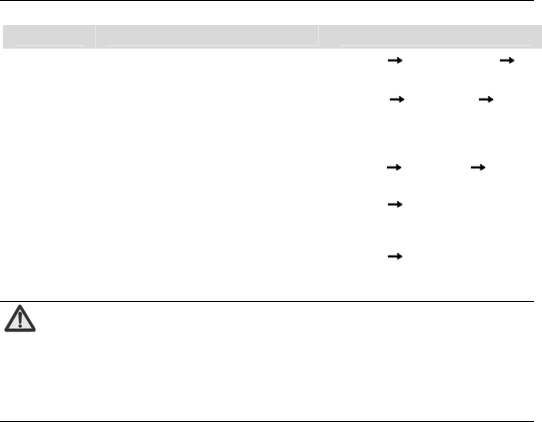
Main function list
39
Function Description Operation
Fixed dial When this is activated, you can only
call numbers on the fixed dial list.
Settings Security settings
Fixed dial
Bluetooth® Exchange data with other Bluetooth®
devices. Also listen to music or talk
hands-free with a Bluetooth®
headset.
Settings Connectivity Blueto
oth®
Data
account
View the Data account. Settings Connectivity Data
account
Restore
factory
settings
Restore the settings your phone had
when it first came out of the box.
Settings Restore factory
settings
Version
information
View phone’s software and hardware
version.
Settings Version information
Note:
When copying files from a PC to a memory card, make your life
easier by putting them in the relevant folder. For example,
music files should go in the ‘My Music’ folder and video files in
the ‘Videos’ folder .

Main function list
40
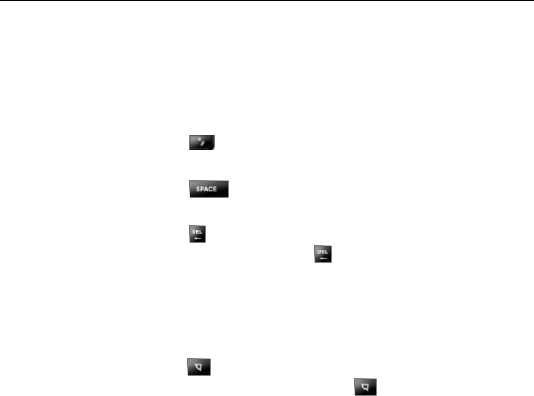
Input what you want, how you want…
41
Input what you want, how you want…
With your phone you can write in: capitals (ABC); lower case (abc); numbers (123) or even
in symbols!
Here’s how to make those choices…
Switch input
method
Press key to change the input method.
Insert a space Press under any input method (except for 123 input
method).
Delete Press to delete anything (letter by letter or number by number)
in front of the cursor or hold to delete everything.
Input ABC/abc Each key is used to input multiple letters. Rapidly press the key
until the letter you want appears.
Input letters and
common symbols
There are two symbols on the keys. In ABC /abc method, press
the key to input the symbol located on the lower part of the key;
press key and then press the key to input the symbol located
on the upper part of the key; press key twice and then press
the key to continuously input the symbol located on the upper part

Appendix
42
of the key.
Input numbers After selecting the 123 input method, choose the numbers you
want.
Input symbols Press to open the symbols keypad and select symbols.
Appendix
Care and maintenance
Your phone is a delicate device. The following advice will help you to keep
it looking good and performing well…
Use a soft dry cloth to clean your phone, battery and charger. Don’t use
liquids such as alcohol, dilution agents or benzene.
From time-to-time, clean the socket where the charger cable connects
to the phone. Dust tends to gather there. This will ensure a really good
connection.
Don’t use needles, pen points or other sharp objects on the keypad or
screen.
Don’t use your phone with wet hands – it could injure you and damage
the phone.

Appendix
43
Don’t use your phone in dusty or dirty environment.
Keep your phone away from extremes of heat – like radiators or ovens.
It may explode if it gets too hot.
If your phone gets wet and the colour of the label on it changes, the
warranty will be void, even if the warranty period hasn’t expired.
If there’s anything wrong with the phone, battery, charger, or any
accessory, please send them to your nearest service centre for
inspection.

Appendix
44
FCC regulations
This mobile phone complies with part 15 of the FCC Rules. Operation is subject to
the following two conditions: (1) This device may not cause harmful interference,
and (2) this device must accept any interference received, including interference
that may cause undesired operation.
This mobile phone has been tested and found to comply with the limits for a Class B
digital device, pursuant to Part 15 of the FCC Rules. These limits are designed to
provide reasonable protection against harmful interference in a residential
installation. This equipment generates, uses and can radiated radio frequency
energy and, if not installed and used in accordance with the instructions, may cause
harmful interference to radio communications. However, there is no guarantee that
interference will not occur in a particular installation If this equipment does cause
harmful interference to radio or television reception, which can be determined by
turning the equipment off and on, the user is encouraged to try to correct the
interference by one or more of the following measures:
-Reorient or relocate the receiving antenna.
-Increase the separation between the equipment and receiver.
-Connect the equipment into an outlet on a circuit different from that to which the
receiver is connected.
-Consult the dealer or an experienced radio/TV technician for help.
Changes or modifications not expressly approved by the party responsible for

Appendix
45
compliance could void the user‘s authority to operate the equipment.
The antenna(s) used for this transmitter must not be co-located or operating in
conjunction with any other antenna or transmitter.
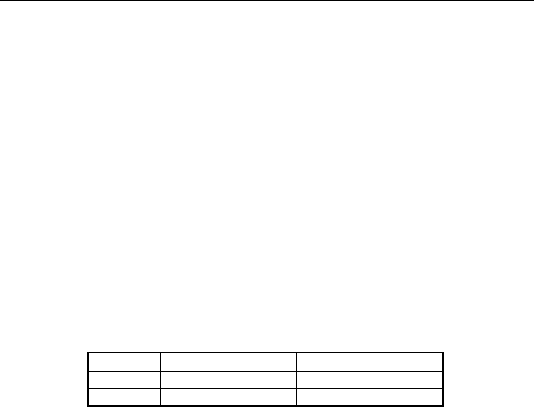
Appendix
46
4RF exposure information (SAR)
This mobile phone meets the government’s requirements for exposure to radio
waves.
This phone is designed and manufactured not to exceed the emission limits for
exposure to radio frequency (RF) energy set by the Federal Communications
Commission of the U.S. Government.
The exposure standard for wireless mobile phones employs a unit of measurement
known as the Specific Absorption Rate, or SAR. The SAR limit set by the FCC is
1.6W/kg. *Tests for SAR are conducted using standard operating positions accepted
by the FCC with the phone transmitting at its highest certified power level in all tested
frequency bands. Although the SAR is determined at the highest certified power level,
the actual SAR level of the phone while operating can be well below the maximum
value. This is because the phone is designed to operate at multiple power levels so as
to use only the poser required to reach the network. In general, the closer you are to a
wireless base station antenna, the lower the power output.
The highest SAR value for the model phone as reported to the FCC, described in this
user guide, is
Position 850MHz (W/Kg) 1900MHz (W/Kg)
Head 1.218 1.437
Body 1.437 0.915

Appendix
47
(Body-worn measurements differ among phone models, depending upon available
accessories and FCC requirements.)
While there may be differences between the SAR levels of various phones and at
various positions, they all meet the government requirement.
The FCC has granted an Equipment Authorization for this model phone with all
reported SAR levels evaluated as in compliance with the FCC RF exposure
guidelines. SAR information on this model phone is on file with the FCC and can be
found under the Display Grant section of http://www.fcc.gov/oet/fccid after searching
on FCC ID:XXX-XXXXX.
For body worn operation, this phone has been tested and meets the FCC RF
exposure guidelines for use with an accessory that contains no metal and the
positions the handset a minimum of 1.5 cm from the body. Use of other accessories
may not ensure compliance with FCC RF exposure guidelines. If you do no t use a
body-worn accessory and are not holding the phone at the ear, position the handset a
minimum of 1.5cm from your body when the phone is switched on.
This device is compliance with SAR for general population /uncontrolled exposure
limits in ANSI/IEEE C95.1-1999 and had been tested in accordance with the
measurement methods and procedures specified in OET Bulletin 65 Supplement C.

Appendix
48
Declaration of RoHS compliance
We’re determined to reduce the impact we have on the environment and take
responsibility for the earth we live on. So this document allows us to formally declare
that the ZTE U5100, manufactured by ZTE CORPORATION, fully complies with the
European Parliament’s RoHS (Restriction of Hazardous Substances) Directive
2002/95/EC, with respect to all the following substances:
(1) Lead (Pb)
(2) Mercury (Hg)
(3) Cadmium (Cd)
(4) Hexavalent Chromium (Cr (VI))
(5) Polybrominated biphenyl (PBB)
(6) Polybrominated diphenyl ether (PBDE)
Our compliance is witnessed by written declaration from our suppliers. This confirms
that any potential trace contamination levels of the substances listed above are below
the maximum level set by EU 2002/95/EC, or are exempt due to their application.
The ZTE U5100 manufactured by ZTE CORPORATION, meets all the requirements
of EU 2002/95/EC.

Appendix
49
Disposal of your old phone
1. When the wheelie bin symbol is attached to a product, it
means the product is covered by the European Directive
2002/96/CE.
2. All electrical and electronic products should be disposed of
separately from normal household waste via designated
collection points provided by government or local
authorities.
3. The correct disposal of electrical and electronic products
will help protect the environment and human health.
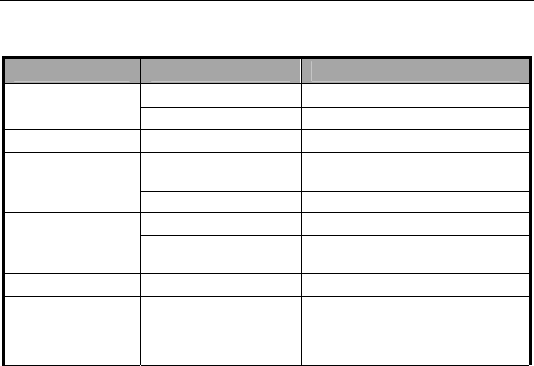
Appendix
50
Problems and their solutions
Symptoms Possible Causes Solutions
Phone won’t turn
on
The battery is flat Charge the battery
Poor contact Reinstall the battery
Phone turns itself Battery very low Charge the battery
Poor standby time
Deceasing of battery
performance Replace the battery
Weak network signal Turn off the phone
Can’t connect to
the network
Weak network signal Move to where the signal is
Out of the service
area Make sure you’re in a network
service area.
Calls keep cutting Weak network signal Move to where the signal is
Phone doesn’t
ring when I
receive incoming
calls
Phone is set to ‘Mute’
or minimum volume.
Enter ‘User Profiles’ to select a
Non-silent mode, or increase the
ring volume.

Appendix
51
Received prompt
asking me to input
‘PUK’
SIM locked because
wrong PIN entered
three times.
Contact your service provider and
ask for a PUK.